The ecommerce market is growing at a rapid rate.
According to a 2022 Insider Intelligence report, ecommerce sales reached $5.2 trillion in 2021. Experts expect sales to grow by 56% to $8.1 trillion by 2026. As the market evolves, so do the needs of consumers and the tools needed to serve them.
Many businesses are switching to headless commerce solutions to reach more customers and keep up with market trends.
Unlike old ecommerce platforms, headless solutions decouple the presentation layer of your website from the backend and allow you to create new and exciting customer experiences.
Let’s explore this new headless approach to ecommerce businesses and how you can use them to enhance the quality of your service.
- What are headless commerce solutions?
- How headless commerce works
- Best headless ecommerce platforms
- Ideal use cases for headless commerce solutions
- Downsides of headless commerce platforms
- Final thoughts: Top headless commerce solutions for online stores
What are headless commerce solutions?
A headless commerce solution uses headless architecture. It separates the frontend functionality of your website from its backend commerce functionality.
With headless architecture, you have complete control over the customer experiences you can create and how your business processes run.
Let’s say you want to create an exceptional frontend design using emerging tools and frameworks. With a headless platform, you can do that without worrying about how it will work with your backend.
The backend is a separate infrastructure that can later integrate and communicate with your current frontend using an application programming interface (API).
Traditional ecommerce platforms pack everything together. But a headless commerce platform gives you complete functionality whenever you need it — regardless of your frontend.
It also allows you to build experiences that pull users from all sales channels and devices to your online store without limitations.
That way, you deliver products, blog posts, content, and other resources to your customers regardless of their devices or platforms.
How headless commerce works
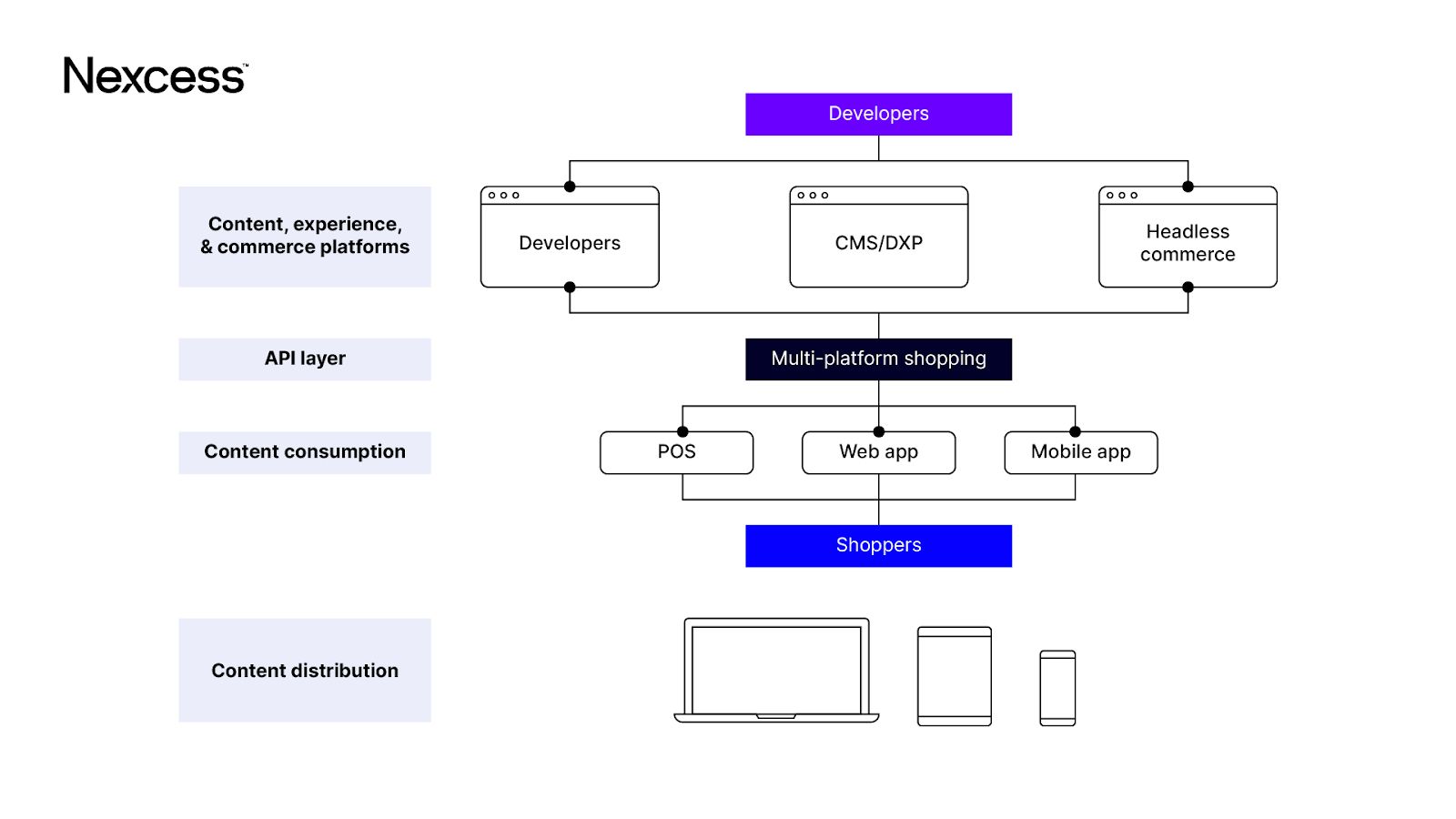
For a headless commerce solution to work, it needs the API. The API connects the frontend to the backend systems, allowing real-time information to flow between them.
The beauty of APIs is that you can leverage several systems to provide customers with extended services and a seamless experience.
The tools you can use include:
- Content management system (CMS)
- Customer relationship management (CRM)
- Digital experience platform (DXP)
- Progressive web application (PWA)
Depending on what your business needs, you can always add more tools and software-as-a-service (SaaS) features. Your customers won’t even know what systems you use in the background. They’ll only enjoy the service you provide.
So how do these APIs work on your website?
Whenever a customer interacts with your frontend touchpoints, it sends an API call to your backend. The backend processes the request and returns the expected result.
Let’s say you run an online ebook marketplace. Once a customer pays, a digital download automatically begins. But how does it work? When they click the “download” button, the frontend sends an API call to the application layer in the backend to process the request.
Within seconds, the backend confirms the purchase and returns the requested file to the frontend. Then, the file instantly downloads to the customer’s computer or mobile device.
Best headless ecommerce platforms
- Magento Commerce (Adobe Commerce).
- BigCommerce.
- Shopify Plus.
- Salesforce Commerce Cloud.
If you’re in the market for a headless ecommerce platform, here are some top examples you can pick from.
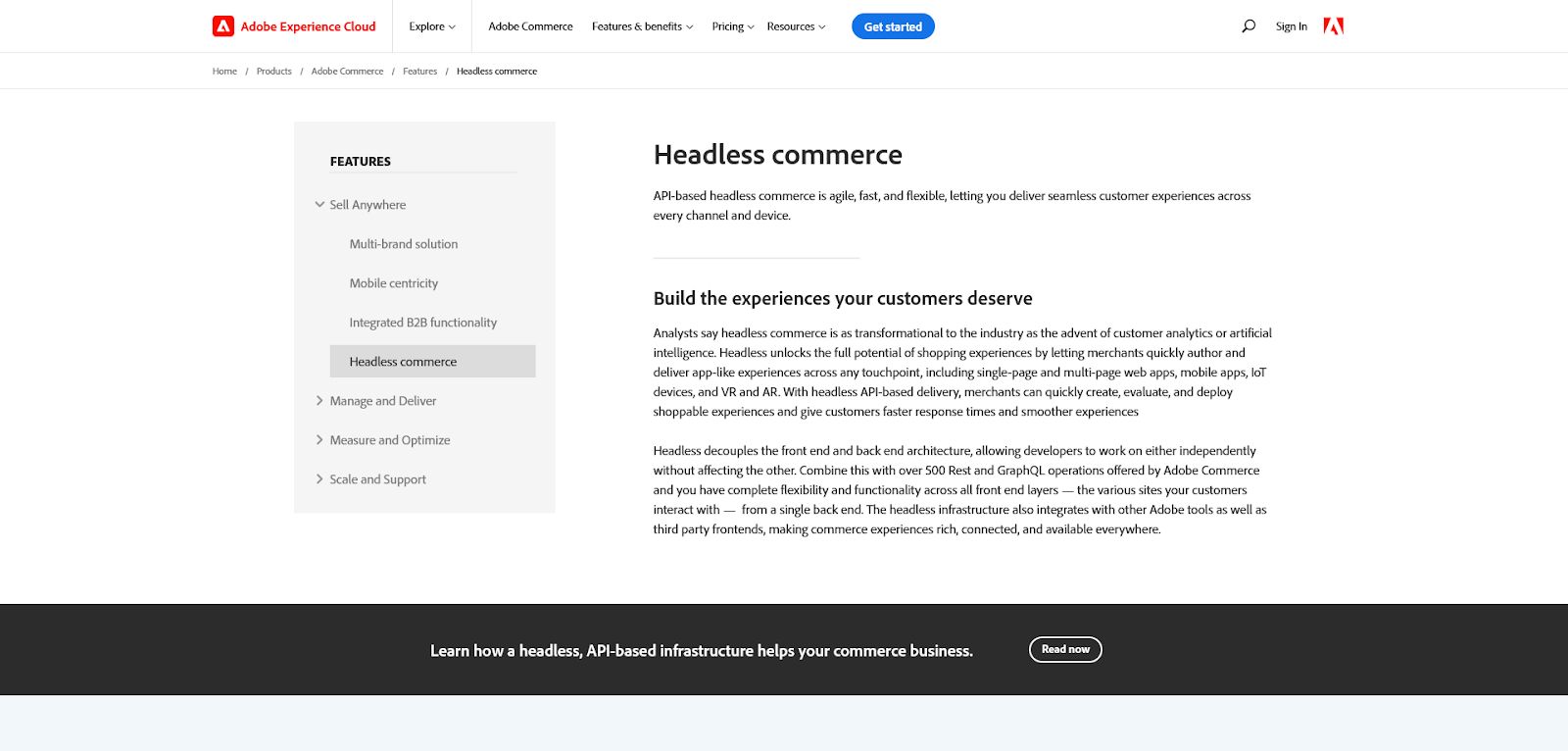
Magento Commerce, also known as Adobe Commerce, is an excellent headless ecommerce platform. With Magento Commerce, you can deliver experiences across multiple touchpoints. This includes web apps, augmented reality (AR), virtual reality (VR), and internet of things (IoT) devices.
You can connect ERPs, CRMs, and other CMS solutions to Magento Commerce. Also, it supports many native and third-party APIs. You can connect it to other tools in the Adobe Suite, including Analytics and the Creative Cloud.
Interested in this headless ecommerce platform? Nexcess can get you up and running as soon as possible with the fully managed Magento hosting plan. You can access Magento’s PWA technologies and enjoy unparalleled support with integrations and setup guides.
Key features
- Supports omnichannel selling.
- Futureproof — supports AR, VR, and IoT.
- Integrates with multiple CMS, CRM, and ERP APIs.
- Supports other Adobe Suite tools.
- Can come with fully managed hosting.
Get fully managed Magento hosting
Accelerate your store's potential, without the tedious maintenance
BigCommerce

BigCommerce is a modern SaaS platform that lets retailers sell products and services online. You can freely customize this open solution, which supports multiple APIs and other integrations.
Its enterprise-level services are ideal for any online retailer, regardless of size. What’s more, BigCommerce’s headless approach lets you use a custom frontend to create a unique customer experience.
It’s pretty straightforward to set up. But you may need help from its developer resources for more advanced uses and some integrations.
One key feature is its ability to handle a high to unlimited API call volume. That means it can run several API calls at once from more than one user without breaking your website. Besides that, it can support multiple endpoints that simplify your backend functionality.
Key features
- Supports multiple endpoints.
- Has a heavy focus on API development.
- Supports high volumes of API calls.
- Comes with plenty of documentation for advanced uses.
- Integrations, although they can be difficult to set up.
Shopify Plus
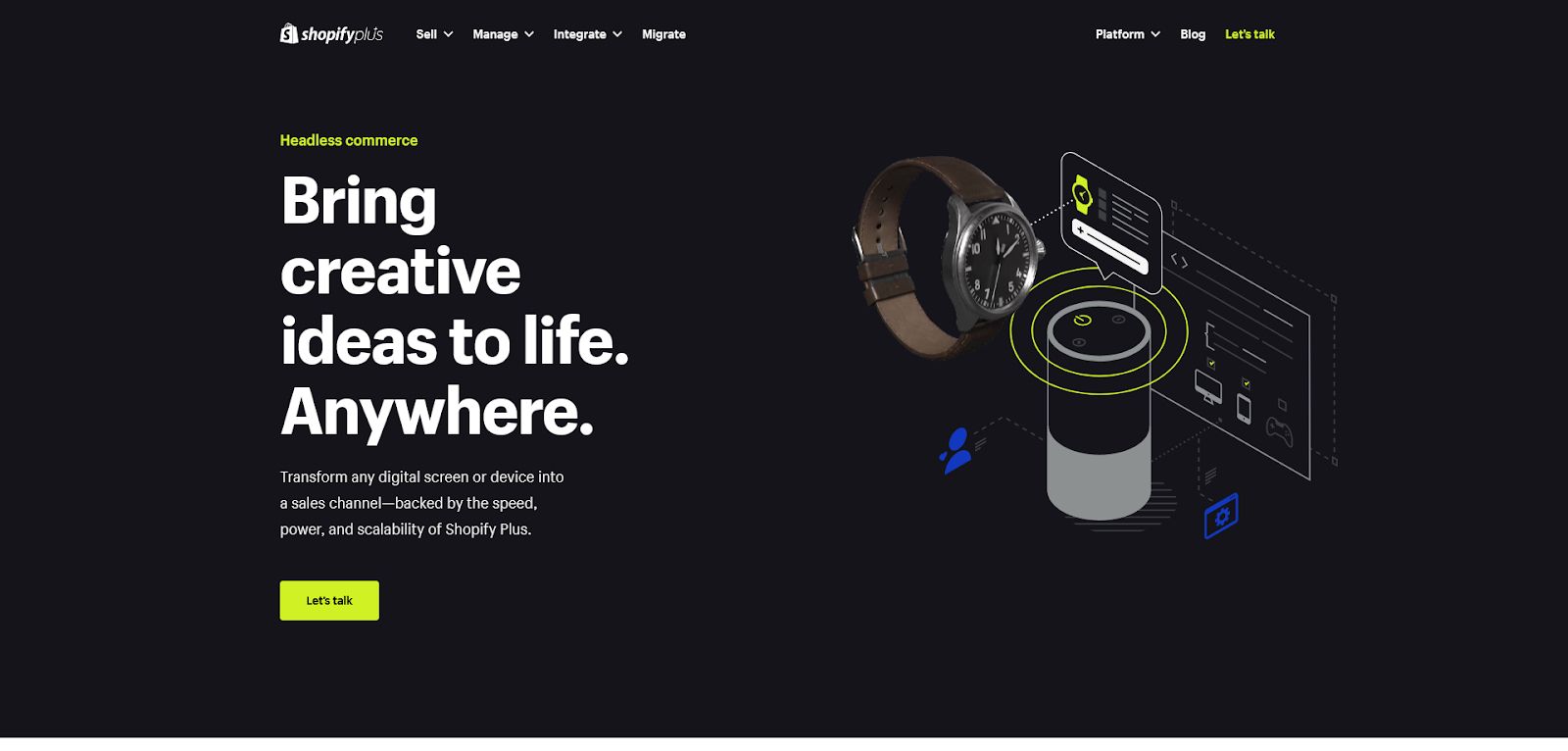
Shopify Plus is another headless CMS and ecommerce solution. It supports multiple integrations and automation. That gives you control over how your website looks and works.
Your design team can build custom ecommerce experiences for your audience using tools they already know and the backend tools that come with Shopify Plus.
With Shopify’s Storefront API, you can design your website and app fast and reduce your time to market. It works for mobile apps, PCs, and gaming platforms. Also, it integrates easily with CRMs, other CMS platforms, and enterprise resource management (ERP) solutions.
Despite its dynamic features and scalability, Shopify Plus is still user-friendly. You can build your backend using pre-built templates and solutions. You can also use Shopify’s presentation layer.
If you’re a skilled developer, you can build something custom and extend its capabilities depending on your needs.
Shopify Plus has a network of partners who can help you build your user interface faster.
On the downside, this ecommerce solution might be too expensive for some online stores.
Key features
- Supports omnichannel selling.
- Integrates with multiple CMS, ERP, and CRM software.
- Supports custom storefronts.
- Comes with a network of Shopify partners.
Salesforce Commerce Cloud
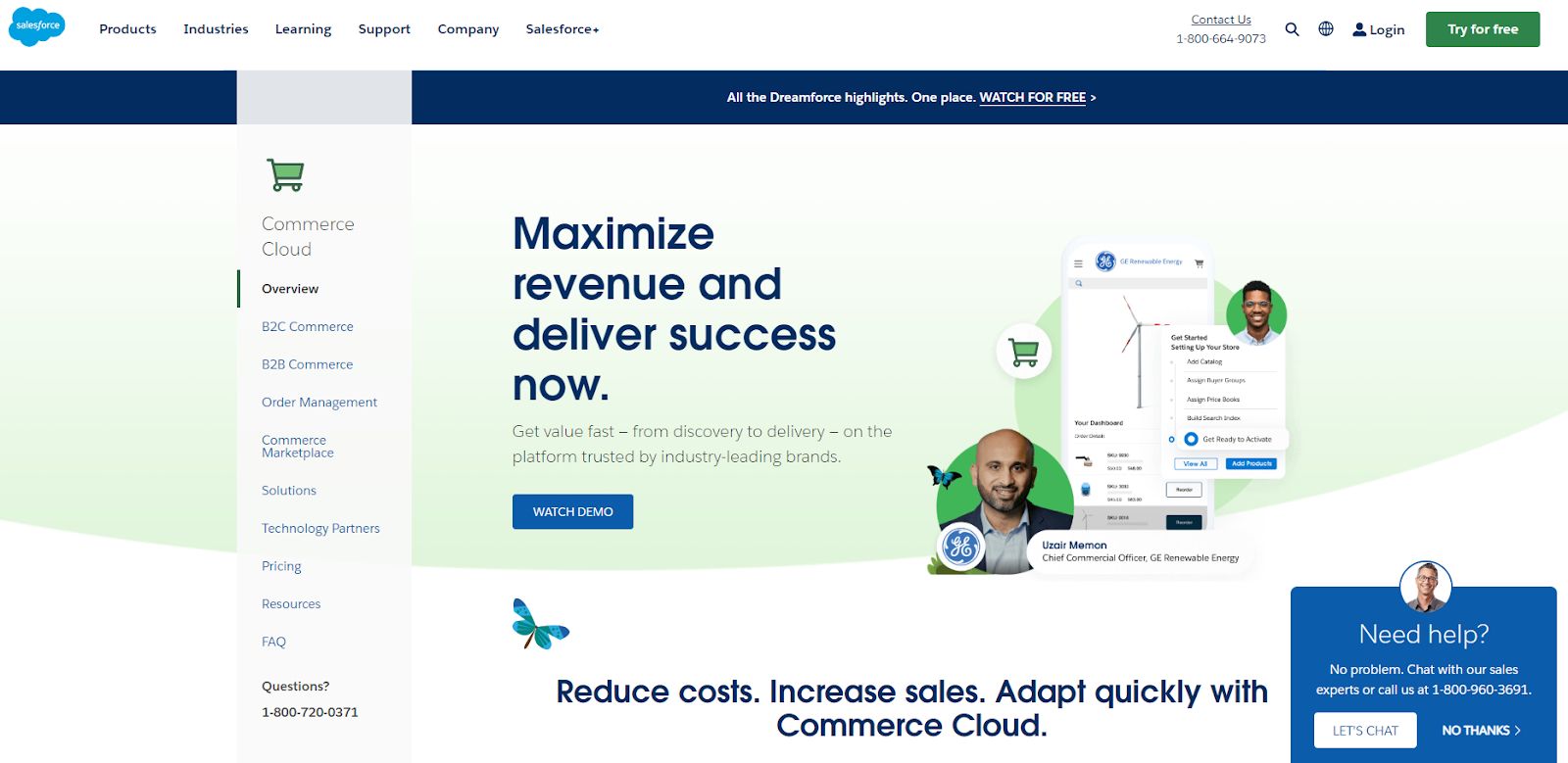
Salesforce Commerce Cloud is a service offered by Salesforce on top of its CRM. That makes connecting it to other Salesforce products incredibly seamless. But it can be difficult to use with non-Salesforce products.
Using the Salesforce Composable Storefront, you can build progressive web apps and other agile solutions to create custom user experiences for your customers.
You’ll find Salesforce Cloud easy to use since it’s an API-first solution. Also, it has a vast library of preexisting integrations that can help extend your store’s functionality and even build mobile applications.
Plus, this lightweight tech stack delivers excellent performance with low latency for your ecommerce business.
Key features
- Has a massive library of pre-built integrations.
- Built on top of Salesforce CRM.
- Supports other Salesforce products.
Ideal use cases for headless commerce solutions
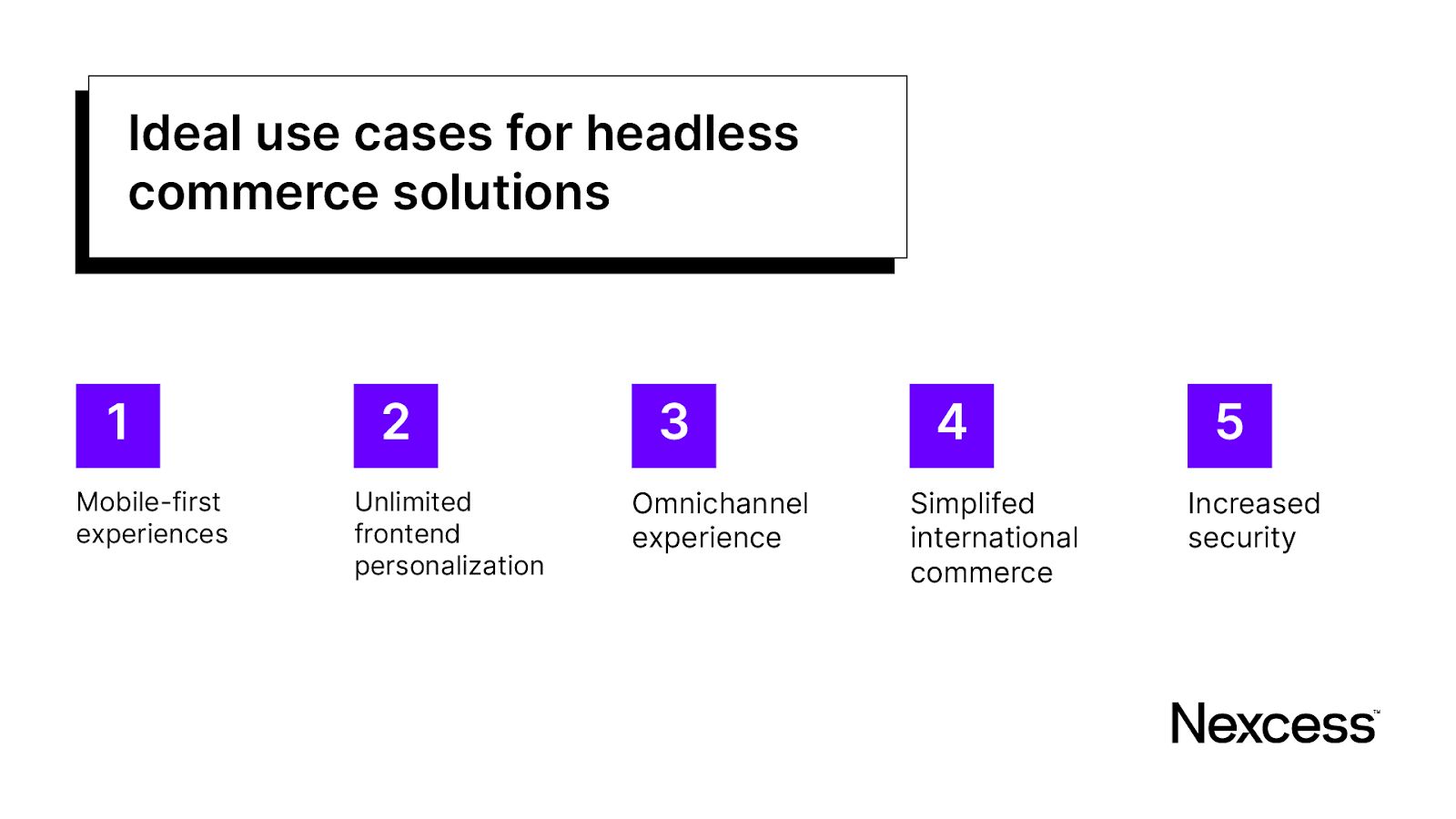
So, what problems can a headless ecommerce platform solve for you? Let’s look at some everyday use cases for these solutions.
Building mobile-first experiences
Suppose your business strategy involves creating a mobile-first platform because most of your users have smartphones. The best way to go would be a headless commerce solution.
There’s no need to build a native app for the device. Instead, you can give your customers an identical experience with a web app.
Headless commerce platforms let you customize your store for smartphones and other mobile devices without investing in infrastructure for native mobile apps.
Wondering how we compare?
Learn how Nexcess delivers more value than any other host
Unlimited frontend personalization
Headless commerce solutions have an open-source architecture that lets you create your desired frontend experience. You can use any tools, coding languages, or CMS you prefer without changing to a new platform.
Also, many headless commerce solutions come with pre-built integration and support for third-party options and APIs. That way, you can customize your customer experiences even further.
Some even have software development kits (SDKs) that let you build custom frontends and tools that give your ecommerce store unique features and functionality.
Omnichannel experience
Headless architecture also lets you offer an omnichannel experience. You can integrate social media and CMS features into your online store.
Also, you can add other marketplaces like:
- Amazon.
- eBay.
- Facebook Marketplace.
- Etsy.
- Instagram.
Moreover, you can take your experience across devices, from phones and PCs to VR, AR, IoT, and web apps. Your business can reach more customers across channels, devices, and borders, regardless of the platform.
Simplify international commerce
Are you serving more than one market? Suppose you have customers from across the world. How do you manage them all at once?
A headless commerce solution helps you build and manage a multilingual ecommerce website that serves multiple markets, all from one codebase. It also lets you customize your frontend for each market without changing the backend.
Increased security
Complying with Payment Card Industry (PCI) standards can be quite hectic on your own. But headless architecture providers solve that problem in the easiest way possible.
There’s no need for your internal IT department to build and test fraud prevention and secure checkout processes. The headless commerce solution does it for you.
Most headless commerce platforms have automation, built-in tools, and features that comply with global fraud protection requirements.
Downsides of headless commerce platforms
Although headless commerce solutions can revolutionize your online business, they have their disadvantages. Here are some possible downsides to using them:
Headless commerce is an expensive venture
Running a headless commerce platform can get pretty expensive. Each system you integrate into your platform comes at its own individual cost.
For instance, you’ll pay a separate cost to build the frontend and the backend. Then, you’ll pay for every CRM, ERP, and API you integrate into your online store. You’ll also pay for the IT team that manages and maintains your infrastructure.
Headless commerce is still new
Headless commerce solutions are still in their infancy, so you may experience some of the industry’s growing pains. Some offerings still lack API endpoints, so you may have to create new ones yourself.
Also, some APIs may not work for your chosen headless solution.
Headless commerce is complex
Building and knitting together different tools can be complex. It may mean writing custom code and implementing custom APIs. That also means using different coding languages and frameworks and a complex project management process.
Not every business has the time, money, or expertise to invest in such a plan.
Final thoughts: Top headless commerce solutions for online stores
To recap, headless ecommerce platforms separate the frontend from the backend of your website. They let you create unique experiences for your customers.
They rely on APIs, which allow information to flow between the two sides quickly and efficiently. You can connect plenty of services and tools to your headless ecommerce platform and still give your users a seamless experience.
But headless commerce solutions have some drawbacks, especially for small businesses. They can be pretty expensive to set up and manage. They also require complex project planning and management, which may take time if you’re trying to manage your website on your own.
If you’re ready for the future of ecommerce, talk to us about our Magento hosting plans. If you need more time before you leap to headless ecommerce, then consider one of our fully managed WooCommerce hosting plans.
Nexcess delivers incredible performance for your ecommerce website while keeping everything accessible for you and your team.
Check out our plans to get started today.

